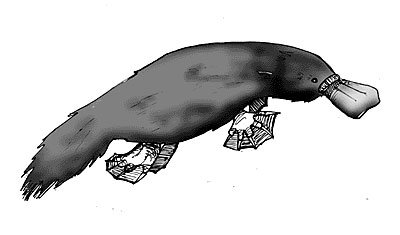


|

Illustration by Arnie Bermudez
|
|
Arizona Daily Wildcat
Thursday, November 20, 2003
Print this
Fastfacts
The correct classification of the platypus, a native of Australia and Tasmania, has been a problem that has puzzled biologists and zoologists since the animal was discovered in the 18th century. This strange animal has characteristics of both mammals and birds. For instance, the platypus lays eggs, as birds do. Yet platypus mothers nurse their young, a typical mammalian characteristic. (However, the platypus has no nipples. The mother secretes milk from stomach glands and the baby laps it up.) The platypus has a leathery, duck-like bill (from which it gets the name "duckbilled platypus"), and its feet are webbed like those of aquatic birds. But at the end of the webs are claws, just like a cat or a raccoon. After much argument, scientists finally decided that the platypus merited classification as a mammal - but only marginally.
Insects can perceive a range of light far greater than that discernible by man. Most insects, for instance, can see ultraviolet light, and many varieties of beetles can see infrared. Insects are unable to focus their eyes, however, and can discern objects clearly only from several inches away. Most insects' eyes are made up of tiny six-sided lenses, and sometimes (as in the dragonfly) as many as 30,000 of these lenses cover the retina. This means that insects do not perceive a single image, as humans do, but see a staggering number of separate images that, when combined, would appear to us as a colossal mosaic. Insects, furthermore, have no eyelids. Their eyes are always open.
Charles Goodyear (1800-1860), the man who developed vulcanized rubber and became the first to produce it commercially, began his experiments in prison. In jail for debt, Goodyear started tests in his prison cell in 1834. After his release several years later, he hit upon vulcanization quite by accident when he dropped some rubber mixed with sulfur on a stove and noted that it did not dissolve.
Something to say? Discuss this on WildChat
Or write a Letter to the Editor
|
|

|
